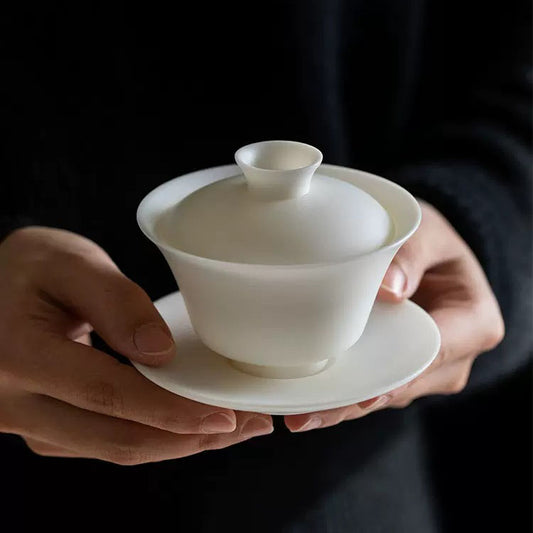I. Origin of the Glaze Beaker
The Glaze Beaker first appeared in the Song Dynasty and was produced by the imperial kiln factory at that time. The imperial kiln factory was the royal production site for porcelain in the Song Dynasty, and the porcelain craftsmanship here was of an extremely high level. The Glaze Beaker became one of the representative works of the imperial kiln factory, embodying the efforts and wisdom of ancient ceramic masters.
II. Characteristics of the Glaze Beaker
The most significant characteristic of the Glaze Beaker is the color and texture of its glaze. The Mutton fat jade porcelain glaze color is milky white, fine in texture, and has a jade-like luster. The surface of the Glaze Beaker's glaze is processed through multiple firings and fine craftsmanship to create a charming gradient effect. The glaze color gradually changes from light to dark from the cup's mouth to its bottom, forming a unique visual beauty.

In addition, the shape of the Glaze Beaker is also exquisitely beautiful. Although its form is simple, the lines are smooth and the proportions are coordinated. The cup's body is thin and has an excellent feel, making people unable to resist trying its porcelain beauty.
III. Production Process of the Glaze Beaker
The production process of the Glaze Beaker is extremely complex and mainly includes the following steps:
Material selection: The Glaze Beaker uses high-quality porcelain clay, which is finely screened and ground to give it a better texture and light transmittance.
Shaping: The Glaze Beaker uses a wheel-throwing process, and skilled technicians use high-speed rotation on the wheel to shape the porcelain clay into a cup shape. It is crucial to control the thickness and curvature of the cup body during the shaping process.
Trimming: The cup needs to undergo trimming after shaping to remove excess porcelain clay and make its surface smoother.
Glaze coating: The glaze coating process of the Glaze Beaker is critical. Technicians need to accurately mix the glaze material and then apply it evenly to the cup. In the process of glazing, the control of the glaze thickness is essential to ensure the gradient effect after firing.
Firing: The firing temperature of the Glaze Beaker is usually between 1300℃ and 1350℃, and the temperature and atmosphere need to be strictly controlled during firing. At this high temperature, the glaze material interacts with the porcelain body to form the unique jade-like texture of the Mutton fat jade porcelain.
Polishing: The fired Glaze Beaker needs to undergo polishing treatment to make its surface smoother and more lustrous.

IV. Collection Value and Heritage of the Glaze Beaker
As a representative work of the imperial kiln factory in the Song Dynasty, the Glaze Beaker has high historical and artistic value. It is not only a gem of ceramic art but also a symbol of Chinese traditional culture. Therefore, the Glaze Beaker has always been highly sought after by collectors. Especially for those heritage pieces, they are extremely valuable.
For example, the Glaze Beaker "Tianqing Glaze Beaker" from the Southern Song Dynasty is a highly representative work. The cup's glaze color is sky blue, with a natural gradient and a jade-like luster. The cup body is thin, with smooth lines and is considered the pinnacle of ceramic art.

V. Conclusion
The Glaze Beaker in the Mutton fat jade porcelain, with its unique glaze color, texture, and craftsmanship, has become a gem of Chinese ceramic art. From its origin, characteristics, production process to collection value, the Glaze Beaker showcases the exquisite craftsmanship and pursuit of beauty by ancient ceramic masters. Today, the Glaze Beaker is still a topic of great interest for ceramic collectors and art enthusiasts, fully demonstrating its unique charm.





